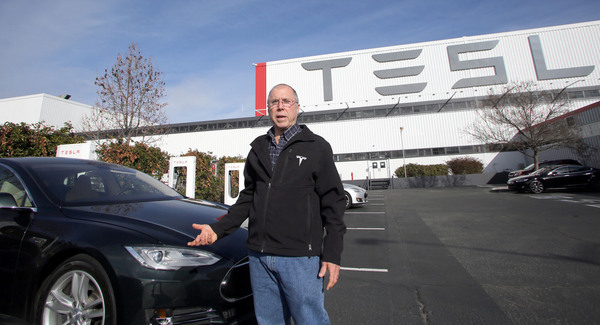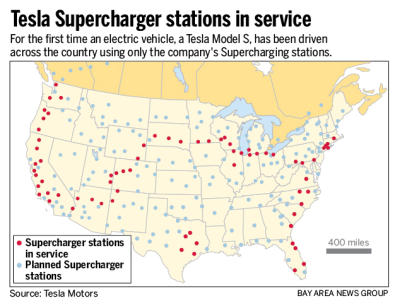Coast to coast in a Tesla Model S, using only free Superchargers

John Glenney is a happy man. He just became the first person known to drive coast-to-coast in a Tesla Model S. Not only that – he used only the company’s network of free Supercharger stations for fuel.
“Electric cars are normal; they are not oddities,” Glenney, 62, a retired professor of biochemistry who lives in Lexington, Ky., said in a phone interview. “I feel like I’ve made my own contribution to the movement of getting off of fossil fuels.”
Glenney’s co-pilot for the journey was his 26-year-old daughter, Jill Glenney. The duo left New York on Jan. 20 and arrived in Los Angeles on Saturday. Jill then hopped on a plane home to Hoboken, N.J., while Glenney began a cruise up the California coast.
Monday, Glenney drove from Paso Robles to Fremont, where he hoped that Tesla would give him a quick tour of the factory where the Model S is made. He got far more than he expected.
“The workers all lined up and were cheering for me,” said Glenney, who met with manufacturing executives and got a personal three-hour tour. “I was really impressed. It was like a special birthday party.”
A fan of horse racing and electric cars, Glenney has bought four Model S sedans, which makes him something of an oddity in Lexington, where he has yet to meet another Model S owner. His wife Kim drives a red one and he usually drives a white one, to which he has attached a trailer hitch to mow the bluegrass on his farm. The cross-country trip was made in “Ivy,” which is dark green and has an 85 Kwh battery pack and an estimated range of 265 miles per charge. He gave the fourth Model S to his sister in Houston.
Tesla CEO Elon Musk has made the Supercharger stations a core part of Tesla’s business strategy, telling Wall Street analysts last year that “even if there’s a zombie apocalypse, you’ll still be able to travel the country on the Tesla Supercharger network.”
There are 71 Supercharger stations open in the United States, and Glenney says he used 28 of them in his cross-country trip.
 “Tesla has this map of Supercharging stations, and I’ve been obsessing about that map,” he said. “I had my ducks in a row. I knew that as soon as the cross-country route was finished, that other people would try it and I may not be the first. I wanted to be the first.”
“Tesla has this map of Supercharging stations, and I’ve been obsessing about that map,” he said. “I had my ducks in a row. I knew that as soon as the cross-country route was finished, that other people would try it and I may not be the first. I wanted to be the first.”The most stressful part of the trip, he said, was the more than 200-mile leg from Newark, Del., to Somerset, Pa. He made it, but with only 11 miles of charge left in his battery.
“The Supercharger in Hagerstown, Md., wasn’t ready,” Glenney said. “There was a cold front, and I felt like we had a 50 percent chance of making it. But we made it.”
The trip was unscripted and went largely unnoticed outside of the community of Tesla fans. Glenney is not on Twitter or other social media, but he posted email updates on the Tesla Motors Forum page.
“Only issue today was heavy snow 60 miles outside Chicago,” he wrote in one email. “10 mph for an hour. Ice (internal combustion engine) cars stuck in the snow. Model S did great. Charged in Highland Park. Beautiful new facility with service center and gallery.”
On Sunday, CEO Elon Musk tweeted that Tesla will send two teams from Los Angeles on a cross-country trip Friday. He also plans to take his own cross-country trip with his five young sons over spring break.
There are currently 12 Supercharger stations up and running in California, and the Gilroy station is one of the busiest in the state. By 2015, California will have more than 25 Supercharger stations, which are typically located near diners or outlet stores on highways between major metropolitan areas so drivers can grab a bite to eat and use the restroom while their vehicle recharges.
Glenney’s immediate plans are to take it easy.
“I’m heading to Napa Valley,” he said. “I just want to relax and get a massage.”
You can return to the main Market News page, or press the Back button on your browser.

